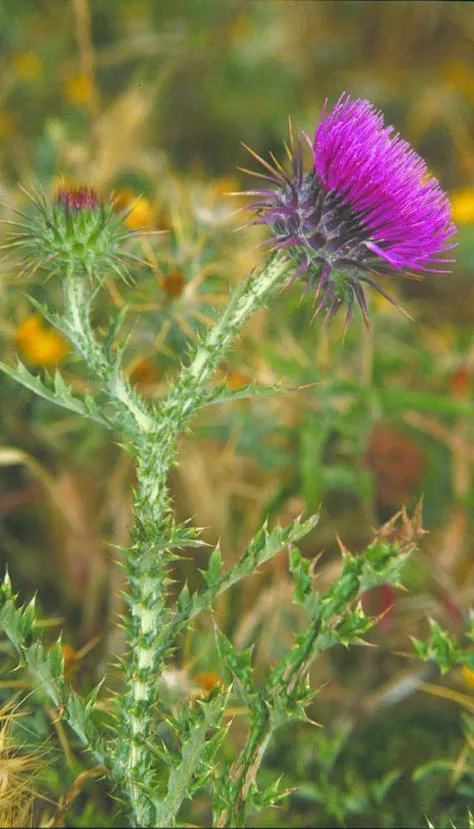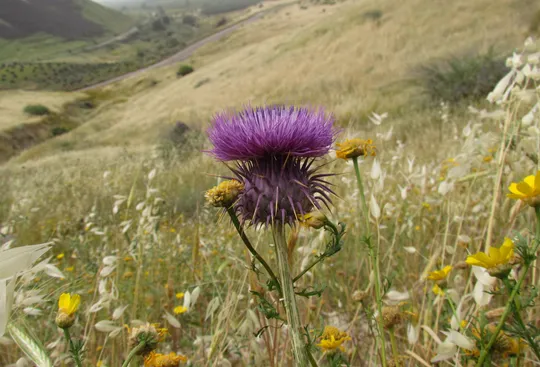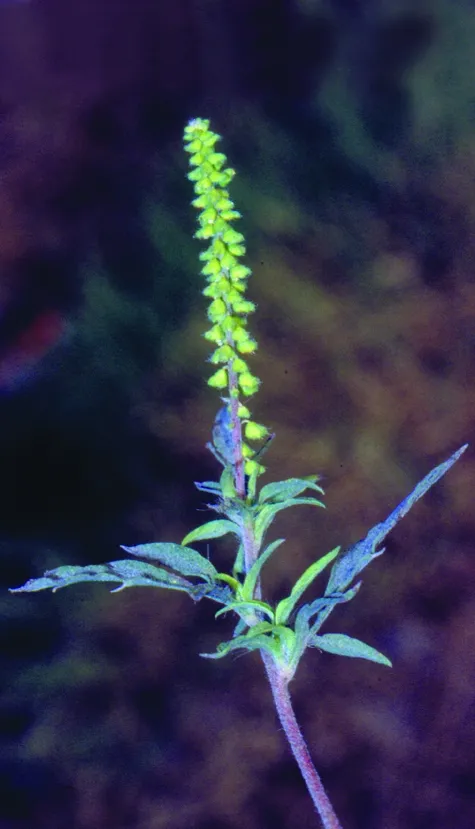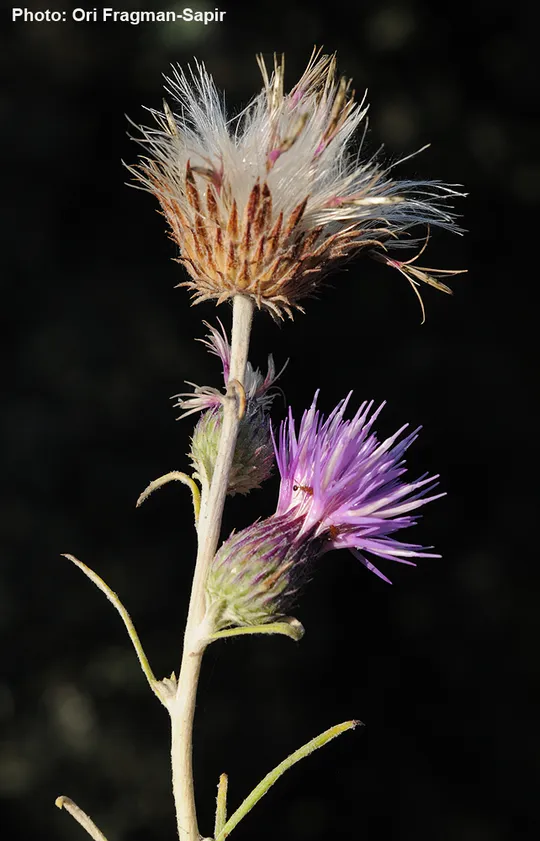Onopordum macrocephalum
Onopordum macrocephalum has been collected from only two sites in the Judean Mountains. It was found in 1938 in the Sanhedria neighborhood in Jerusalem and has since become extinct there. Careful searches since the 1970s and the rare plant survey in 2000-2001 produced no results. It was found in 1973 in the southern Judean Mountains, eight kilometers east of Kibbutz Lahav, in the area of the settlement of Eshkolot. It was not found again, but then no rare species survey was conducted in the area. Interestingly, the species, which is characteristic of high areas, was not found on the Ma'on Ridge but rather in the lower section of the southern Mount Hebron slopes.
High plains and transition zone batha (scrubland) on loess soil, mostly in valleys and in disturbed habitats. O. macrocephalum is fairly common in Jordan at altitudes of 700-1400 meters throughout Edom and Moab, in eastern Ammon and Gil'ad, in the 200-350 mm rain zone, particularly on roadsides.
The genus Onopordum includes 50 species of perennial herbaceous thistles,
with spiny winged stems.
Its distribution center is in the Middle East and in the Irano-Turanian region. Most of the species tend to concentrate in a given area and are adapted to the particular ecological conditions of that area. Eight species grow in Israel, particularly
in the transition zone between the Mediterranean and Irano-Turanian regions – an area known as the speciation center
of the Onopordum genus. The genus Onopordum has a
characteristic stem along which are extremely spiny wings – a feature found in only a few other genera in the family: Scolymus, Cirsium and Carduus.
O. macrocephalum belongs
to a group in the genus, which has a characteristic large capitulum and an unbranched flowering stalk. Other species in
the group include O. palaestinum, O.alexandrnum, O.anisacanthum and O.ambiguum. All the species in this group are endemic to the
Levant, with small ranges and an affinity for transition zones. O. macrocephalum is the only prone species, blooming near the ground, unlike
the other
species, which bloom at a height of a
meter and more.
Onopordum macrocephalum
is pollinated primarily by medium-sized
and large bees. The
flowering heads give off an intense sweet smell. Many insects are found on the flower
heads – butterflies,
colorful giant wasps, and beetles from the weevil family (Curculionidae). The beetles eat the flowers and do not contribute to pollination.
·
Of the two Onopordum macrocephalum sites in Israel, one is clearly extinct (in Jerusalem) and the other is suspected to be
extinct. Although
32 years have elapsed since the time of collection, until a thorough rare plant survey is conducted in the Lahav-Rahat area the species cannot be declared extinct.
Onopordum macrocephalum is very easy to propagate from
seed. If a source of seeds is not found in Israel, they should be collected from Jordan and reintroduced
to two sites characteristic
of the transition zone batha habitat. These are the Northern Lahav Nature
Reserve – as the plant was found close by in 1973, and the Tel Krayot
Reserve (Mount Amasa) on the Ma'on Ridge, where conditions are similar to those of sites Jordanian sites where O.
macrocephalum is common. The characteristics of the plant should be
studied from its habitat in Jordan, because of the lack of information on the populations in Israel.
Onopordum macrocephalum is endemic to
the Levant: Israel, all the regions of
Jordan and the Syrian Desert. The species is characteristic of transition zone batha, which does not penetrate the
Mediterranean region (absent in Lebanon) or the extreme desert (absent in the Negev).
Onopordum macrocephalum is a perennial thistle sub-endemic to Israel and the Levant. Although it is a common species in Jordan, in Israel it is on the brink of extinction, or possibly even extinct. The two sites in Israel from which it
was collected – one
in Jerusalem, from where O.
macrocephalum is extinct for forty years or more, and the other near Lahav, where it has not been found for thirty years. It should be searched for, but at the same time,
it should be reintroduced to Israel from sources in Jordan.
ראה חוחן קרדני
Current Occupancy Map
| 1000 squre meter pixel | 5000 squre meter pixel | 10000 squre meter pixel | |
|---|---|---|---|
| number of observations | 0 | 0 | 0 |
| in total pixels | 0 | 0 | 0 |
| Family | Asteraceae |
| Classification | On the endangered species list |
| Ecosystem | Semi-Steppe Belt, High Semi-Steppe |
| Chorotype | Endemic (Western – Irano – Turanian) |
| Conservation Site | Lahav Nature Reserve |
| Rarity |
1
6
6
|
|---|---|
| Vulnerability |
0
0
4
|
| Attractiveness |
0
0
4
|
| Endemism |
0
2
4
|
| Red number |
1
4.7
10
|
| Peripherality | N |
| IUCN category | DD EW EX LC CR EN VU NT |
| Threat Definition according to the red book | Endangered |
 Based on:
Based on:






